- Clone
- 1A1 (See other available formats)
- Regulatory Status
- RUO
- Other Names
- TNFRSF13B, CD267, Transmembrane Activator and CAML Interactor (TACI)
- Isotype
- Rat IgG2a, κ

-

Human peripheral blood lymphocytes stained with CD19 PE/Cyanine5 and 1A1 PE
| Cat # | Size | Price | Quantity Check Availability | ||
|---|---|---|---|---|---|
| 311906 | 100 tests | $304.00 | |||
TACI, Transmembrane Activator CAML (calcium modulator and cyclophilin ligand) Interactor, is a 32 kD type III transmembrane protein. It belongs to TNF receptor superfamily, known as TNFRSF member 13B (TNFRSF13B) or CD267. TACI is expressed on B cells, and myeloma cells. TACI contains 2 cysteine-rich domains (CRDs). Recent studies, however, have shown that another shorter form (TACI_d2) of TACI exists wherein the N-terminal CRD is removed by alternative splicing. TACI_d2 contains full affinity for its ligands. Several proteins (BAFF/BLys, APRIL, Syndecan-2) have been identified as TACI ligands. The interaction of TACI with its ligands induces activation of the transcription factors NFAT, AP1, and NF-κ B and plays a crucial role in humoral immunity by negative regulation of B cell proliferation and survival.
Product Details
- Verified Reactivity
- Human
- Reported Reactivity
- African Green, Baboon, Cynomolgus, Rhesus
- Antibody Type
- Monoclonal
- Host Species
- Rat
- Immunogen
- TACI-transfected RBL cells
- Formulation
- Phosphate-buffered solution, pH 7.2, containing 0.09% sodium azide and BSA (origin USA)
- Preparation
- The antibody was purified by affinity chromatography, and conjugated with PE under optimal conditions.
- Concentration
- Lot-specific (to obtain lot-specific concentration, please enter the lot number in our Concentration and Expiration Lookup or Certificate of Analysis online tools.)
- Storage & Handling
- The antibody solution should be stored undiluted between 2°C and 8°C, and protected from prolonged exposure to light. Do not freeze.
- Application
-
FC - Quality tested
- Recommended Usage
-
Each lot of this antibody is quality control tested by immunofluorescent staining with flow cytometric analysis. For flow cytometric staining, the suggested use of this reagent is 5 µl per million cells in 100 µl staining volume or 5 µl per 100 µl of whole blood.
- Excitation Laser
-
Blue Laser (488 nm)
Green Laser (532 nm)/Yellow-Green Laser (561 nm)
-
Application References
(PubMed link indicates BioLegend citation) -
- Ng LG, et al.2004. J. Immunol. 173:807. (FC)
- Lougaris V, et al. 2012. Hum Immunol. 73:836. PubMed.
- Product Citations
-
- RRID
-
AB_2203401 (BioLegend Cat. No. 311906)
Antigen Details
- Structure
- Type III transmembrane protein, TNF receptor superfamily, 32 kD
- Distribution
-
B cells, meyloma cells
- Function
- Negative regulation of B cell function
- Ligand/Receptor
- BAFF/BLys, April, Syndecan-2
- Cell Type
- B cells
- Biology Area
- Costimulatory Molecules, Immunology
- Molecular Family
- CD Molecules
- Antigen References
-
1. Gross JA, et al. 2000. Nature 404:995.
2. Wu Y, et al. 2000. J. Biol Chem. 275:35478.
3. Yan M, et al. 2001. Nat. Immunol. 2:638.
4. Hymowitz A, et al. 2005. J. Biol. Chem. 280:7218.
5. Bischof D, et al. 2006. BLOOD 107:3235. - Gene ID
- 23495 View all products for this Gene ID
- UniProt
- View information about CD267 on UniProt.org
Other Formats
View All CD267 Reagents Request Custom Conjugation| Description | Clone | Applications |
|---|---|---|
| Purified anti-human CD267 (TACI) | 1A1 | FC |
| Biotin anti-human CD267 (TACI) | 1A1 | FC |
| PE anti-human CD267 (TACI) | 1A1 | FC |
| PE/Cyanine7 anti-human CD267 (TACI) | 1A1 | FC |
| PE/Dazzle™ 594 anti-human CD267 (TACI) | 1A1 | FC |
| APC anti-human CD267 (TACI) | 1A1 | FC |
| TotalSeq™-A0247 anti-human CD267 (TACI) | 1A1 | PG |
| TotalSeq™-C0247 anti-human CD267 (TACI) | 1A1 | PG |
| TotalSeq™-B0247 anti-human CD267 (TACI) Antibody | 1A1 | PG |
Compare Data Across All Formats
This data display is provided for general comparisons between formats.
Your actual data may vary due to variations in samples, target cells, instruments and their settings, staining conditions, and other factors.
If you need assistance with selecting the best format contact our expert technical support team.
-
Purified anti-human CD267 (TACI)
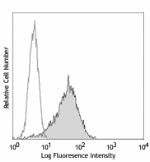
Human TACI transfected cells stained with purified 1A1, foll... -
Biotin anti-human CD267 (TACI)
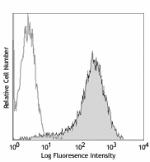
Human TACI transfected cells stained with biotinylated 1A1, ... -
PE anti-human CD267 (TACI)

Human peripheral blood lymphocytes stained with CD19 PE/Cyan... -
PE/Cyanine7 anti-human CD267 (TACI)

Human peripheral blood lymphocytes were stained with CD19 an... -
PE/Dazzle™ 594 anti-human CD267 (TACI)
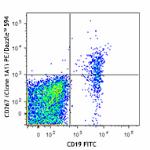
Human peripheral blood lymphocytes were stained with CD19 an... 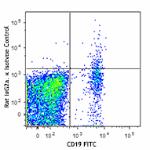
-
APC anti-human CD267 (TACI)
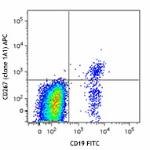
Human peripheral blood lymphocytes were stained with CD19 FI... 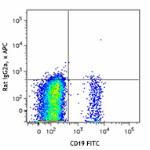
-
TotalSeq™-A0247 anti-human CD267 (TACI)
-
TotalSeq™-C0247 anti-human CD267 (TACI)
-
TotalSeq™-B0247 anti-human CD267 (TACI) Antibody
